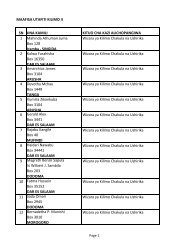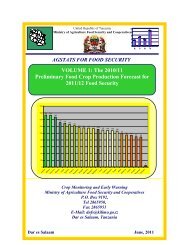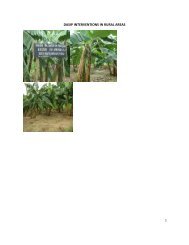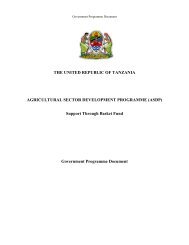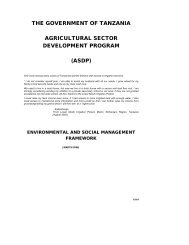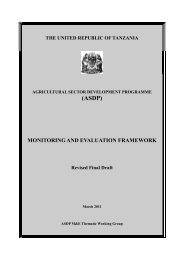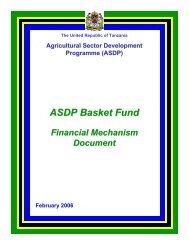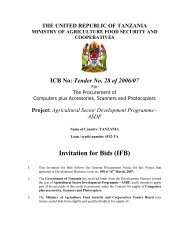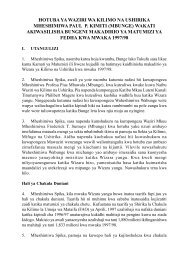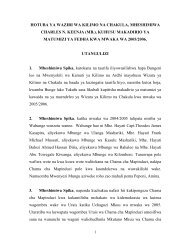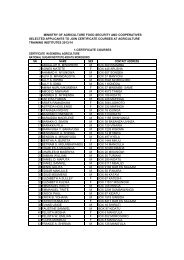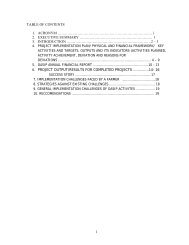Large Scale Farm Report - Ministry Of Agriculture, Food and ...
Large Scale Farm Report - Ministry Of Agriculture, Food and ...
Large Scale Farm Report - Ministry Of Agriculture, Food and ...
Create successful ePaper yourself
Turn your PDF publications into a flip-book with our unique Google optimized e-Paper software.
REGIONAL PROFILES72The region has the fifth highest number of farm implements. It has the sixth largest number of tractors, second largestnumber of harvesters, fifth largest number of ploughs <strong>and</strong> fourth largest number of harrows.Iringa has a moderate number of households receiving extension services <strong>and</strong> also it has the third highest number of farmsirrigating. It has the second highest number of trees planted by large scale farms in the country (3,781,627). The region hasthe second highest number of farms with erosion control/water harvesting bunds in Tanzania with Tree belts, waterharvesting bunds, erosion control bunds, vertiver grass <strong>and</strong> terraces being the most common.The region has the fifth largest number of farms keeping livestock <strong>and</strong> has the fourth highest livestock population on largescale farms. It has the fifth highest number of cattle <strong>and</strong> fourth highest head of goats with small sheep numbers. It has thethird highest number of pigs. Most of the cattle are improved. It is the largest milk producing region in the country in termsof large scale farms with an above average farm gate price.Chicken production is important in Iringa <strong>and</strong> it is the sixth highest producing region. On large scale farms most of thechickens are improved. The region has the fourth highest number of layers <strong>and</strong> sixth highest number of broilers in thecountry. Iringa has the second highest number of eggs produced; most of the eggs are consumed.The rate of infection is moderate to low compared to other regions. Most of the livestock infrastructure <strong>and</strong> services wereat a distance of under 15 kilometers from the farms. However, the access to veterinary clinics <strong>and</strong> input supply serviceswas moderate. Iringa has the seventh highest percentage of large scale farms receiving extension advice. The Governmentis the major source of extension.Iringa has the third highest number of farm employees. It has the second highest number of permanent employees <strong>and</strong> thirdhighest number of temporary employees. The number of female temporary employees was almost equal to the number ofmale temporary employees.4.7 LindiLindi region has 9 large scale farms with a l<strong>and</strong> area totaling of 6,131 hectares under crop production <strong>and</strong> has one of thelowest numbers of annual crop growing large scale farms in Tanzania. Most large scale farms grow crops only <strong>and</strong> veryfew of them have livestock. One large scale farm has livestock only. The l<strong>and</strong> area per farm is 938 ha <strong>and</strong> it has a highpercent of allocated l<strong>and</strong> that is utilized. The region has a high percent of permanent crops, some of which are in monocropst<strong>and</strong>s <strong>and</strong> the remainder in mixed annual/permanent crop. Lindi only has a long rainy season.Cereal production is relatively unimportant in Lindi <strong>and</strong> it has one of the lowest planted areas <strong>and</strong> yields of maize in thecountry. Small quantities of rice <strong>and</strong> sorghum are produced.Lindi has the largest planted area of cashew nut <strong>and</strong> second largest planted area of coconut in the country <strong>and</strong> it has smallquantities of oranges <strong>and</strong> banana. The region has virtually no planted area under irrigation.Lindi has the lowest contact with extension services in the country. It also has no large scale farms planted trees or farmwith erosion control/water harvesting facilities. The region has the smallest number of farm implements <strong>and</strong> assets.Tanzania <strong>Agriculture</strong> Sample Census – 2003



